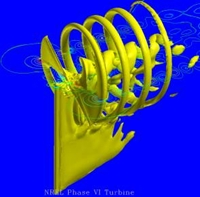 The Numerical wind tunnel is a group of Computational Fluid Dynamics (CFD) tools, which supplements a "real" experimental wind tunnel. The main purpose of this work is to provide very detailed information of the complex wind turbine aerodynamics. It is possible to calculate the aerodynamic characteristics of airfoils, wind turbine blades and rotors, leading to predictions of power and loads.
The Numerical wind tunnel is a group of Computational Fluid Dynamics (CFD) tools, which supplements a "real" experimental wind tunnel. The main purpose of this work is to provide very detailed information of the complex wind turbine aerodynamics. It is possible to calculate the aerodynamic characteristics of airfoils, wind turbine blades and rotors, leading to predictions of power and loads.
Navier-Stokes Solver: The primary flow solver is the EllipSys2D/3D code, which is an incompressible finite volume code developed in a collaboration between Risø and the Technical University of Denmark, DTU.
 Mesh Generation: is taken care of using the HypGrid code. This is a hyperbolic grid generator developed at Risø for both two-dimensional and three-dimensional domains.
Mesh Generation: is taken care of using the HypGrid code. This is a hyperbolic grid generator developed at Risø for both two-dimensional and three-dimensional domains.
Research activities: The main research activities are focused around general rotor aerodynamics, airfoil computations, loads during standstill, tip and hub-region flow, rotor/tower interaction, aerodynamic devices and aeroelasticity.
Projects: The work related to the numerical wind tunnels is sponsored through a series of national and international projects: EFP-2005, EFP-2006, and STVF: Computational Methods in Wind Power Meteorology and EU projects such as UPWIND, STABCON, MEXICO
Computational Resources: The numerical wind tunnel needs large computer resources and both inhouse and national computing centres are used.
Other aerodynamic codes/models that are closely involved in current research include FIDAP and XFOIL, various Blade Element Momentum (BEM) models and finally various Empirical dynamic stall models are available as well.